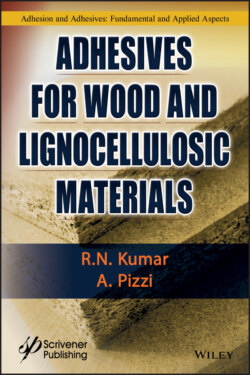Читать книгу Adhesives for Wood and Lignocellulosic Materials - R. N. Kumar - Страница 54
2.4 Theories of Adhesion
ОглавлениеAccording to Schultz and Nardin (1994), the main adhesion theories are as follows:
1 Mechanical interlocking
2 Electronic or electrostatic theory
3 Adsorption (thermodynamic) or wetting theory
4 Diffusion theory
5 Chemical (covalent) bonding theory
6 Theory of weak boundary layers and interphases
The adsorption hypothesis, which explains that adhesion is caused by intermolecular forces such as van der Waals forces, hydrogen bonds, and electrostatic interactions, is widely considered to be the most applicable to wood–polymer adhesion [7]. However, in a porous material like wood, penetration and mechanical interlocking must also play a significant role in the bonding process.
Marra [5] described adhesive bond formation in wood-based panels as a dynamic process consisting of flow, transference, penetration, wetting, and solidification (cure).
The mechanisms outlined above are not mutually exclusive since one or more of the above mechanisms can occur simultaneously depending on the specific conditions prevailing during bonding. The hierarchical cellular characteristics of wood offer such varied conditions.
The mechanical interlocking theory has long been used to explain wood bonding [6].
The electronic or electrostatic theory has been applied to wood in finishing and coating operations, although this adhesion bonding mechanism needs more fundamental research [21]. The adsorption or wetting theory has been exhaustively studied on wood over the past 40 years [7, 8].
The diffusion theory is appropriate in wood bonding during the production of compressed fibrous materials such as hardboard. The thermoplastic matrix, namely, lignin, can soften beyond its glass-transition temperature during the thermal conditions employed during hot pressing. Under these conditions, lignin can diffuse throughout the fibrous mat and react with the furfural liberated from hemicelluloses (pentosans) and solidify due to chemical reaction and hence function as an adhesive.
Besides the diffusion and molecular interpenetration of lignin occurring during wet process in the hardboard production as mentioned above, there is also the phenomenon of diffusion of monomers/oligomers of synthetic resin adhesives such as PF or UF into the wood cells followed by subsequent polymerization. This is an important concept that speaks of monomers that penetrate at a molecular level for thermosetting adhesives [9].
While discussing on the theories of adhesion in wood, one should keep in mind the opposite process (debonding). Weak boundary layers have been identified as the cause for the premature failure of the adhesive bond. In the case of wood bonding, the theory of weak boundary layers has also been proposed and studied. The weak boundary layers can be caused as a result of the mechanical damages occurring during the machining of wood surfaces. Further, the impact of surface aging the consequent inactivating of the wood surfaces [10–12] can also be responsible for the weak boundary layer.
